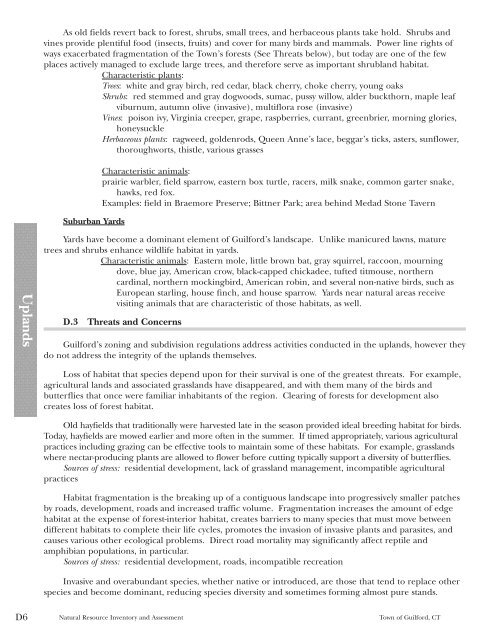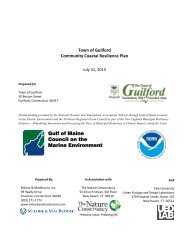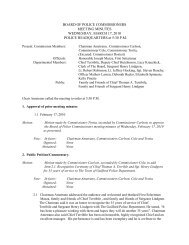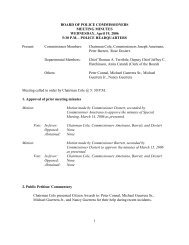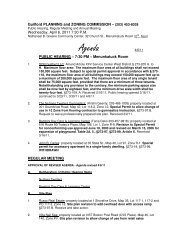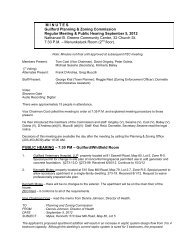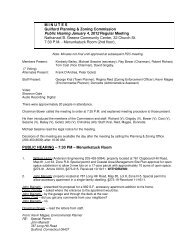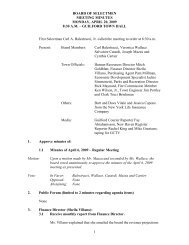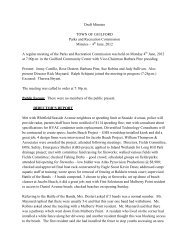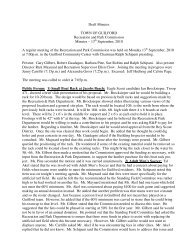Natural Resource Inventory and Assessment - Town of Guilford
Natural Resource Inventory and Assessment - Town of Guilford
Natural Resource Inventory and Assessment - Town of Guilford
Create successful ePaper yourself
Turn your PDF publications into a flip-book with our unique Google optimized e-Paper software.
Upl<strong>and</strong>s<br />
D6<br />
As old fields revert back to forest, shrubs, small trees, <strong>and</strong> herbaceous plants take hold. Shrubs <strong>and</strong><br />
vines provide plentiful food (insects, fruits) <strong>and</strong> cover for many birds <strong>and</strong> mammals. Power line rights <strong>of</strong><br />
ways exacerbated fragmentation <strong>of</strong> the <strong>Town</strong>’s forests (See Threats below), but today are one <strong>of</strong> the few<br />
places actively managed to exclude large trees, <strong>and</strong> therefore serve as important shrubl<strong>and</strong> habitat.<br />
Characteristic plants:<br />
Trees: white <strong>and</strong> gray birch, red cedar, black cherry, choke cherry, young oaks<br />
Shrubs: red stemmed <strong>and</strong> gray dogwoods, sumac, pussy willow, alder buckthorn, maple leaf<br />
viburnum, autumn olive (invasive), multiflora rose (invasive)<br />
Vines: poison ivy, Virginia creeper, grape, raspberries, currant, greenbrier, morning glories,<br />
honeysuckle<br />
Herbaceous plants: ragweed, goldenrods, Queen Anne’s lace, beggar’s ticks, asters, sunflower,<br />
thoroughworts, thistle, various grasses<br />
Suburban Yards<br />
Characteristic animals:<br />
prairie warbler, field sparrow, eastern box turtle, racers, milk snake, common garter snake,<br />
hawks, red fox.<br />
Examples: field in Braemore Preserve; Bittner Park; area behind Medad Stone Tavern<br />
Yards have become a dominant element <strong>of</strong> <strong>Guilford</strong>’s l<strong>and</strong>scape. Unlike manicured lawns, mature<br />
trees <strong>and</strong> shrubs enhance wildlife habitat in yards.<br />
Characteristic animals: Eastern mole, little brown bat, gray squirrel, raccoon, mourning<br />
dove, blue jay, American crow, black-capped chickadee, tufted titmouse, northern<br />
cardinal, northern mockingbird, American robin, <strong>and</strong> several non-native birds, such as<br />
European starling, house finch, <strong>and</strong> house sparrow. Yards near natural areas receive<br />
visiting animals that are characteristic <strong>of</strong> those habitats, as well.<br />
D.3 Threats <strong>and</strong> Concerns<br />
<strong>Guilford</strong>’s zoning <strong>and</strong> subdivision regulations address activities conducted in the upl<strong>and</strong>s, however they<br />
do not address the integrity <strong>of</strong> the upl<strong>and</strong>s themselves.<br />
Loss <strong>of</strong> habitat that species depend upon for their survival is one <strong>of</strong> the greatest threats. For example,<br />
agricultural l<strong>and</strong>s <strong>and</strong> associated grassl<strong>and</strong>s have disappeared, <strong>and</strong> with them many <strong>of</strong> the birds <strong>and</strong><br />
butterflies that once were familiar inhabitants <strong>of</strong> the region. Clearing <strong>of</strong> forests for development also<br />
creates loss <strong>of</strong> forest habitat.<br />
Old hayfields that traditionally were harvested late in the season provided ideal breeding habitat for birds.<br />
Today, hayfields are mowed earlier <strong>and</strong> more <strong>of</strong>ten in the summer. If timed appropriately, various agricultural<br />
practices including grazing can be effective tools to maintain some <strong>of</strong> these habitats. For example, grassl<strong>and</strong>s<br />
where nectar-producing plants are allowed to flower before cutting typically support a diversity <strong>of</strong> butterflies.<br />
Sources <strong>of</strong> stress: residential development, lack <strong>of</strong> grassl<strong>and</strong> management, incompatible agricultural<br />
practices<br />
Habitat fragmentation is the breaking up <strong>of</strong> a contiguous l<strong>and</strong>scape into progressively smaller patches<br />
by roads, development, roads <strong>and</strong> increased traffic volume. Fragmentation increases the amount <strong>of</strong> edge<br />
habitat at the expense <strong>of</strong> forest-interior habitat, creates barriers to many species that must move between<br />
different habitats to complete their life cycles, promotes the invasion <strong>of</strong> invasive plants <strong>and</strong> parasites, <strong>and</strong><br />
causes various other ecological problems. Direct road mortality may significantly affect reptile <strong>and</strong><br />
amphibian populations, in particular.<br />
Sources <strong>of</strong> stress: residential development, roads, incompatible recreation<br />
Invasive <strong>and</strong> overabundant species, whether native or introduced, are those that tend to replace other<br />
species <strong>and</strong> become dominant, reducing species diversity <strong>and</strong> sometimes forming almost pure st<strong>and</strong>s.<br />
<strong>Natural</strong> <strong>Resource</strong> <strong>Inventory</strong> <strong>and</strong> <strong>Assessment</strong> <strong>Town</strong> <strong>of</strong> <strong>Guilford</strong>, CT


